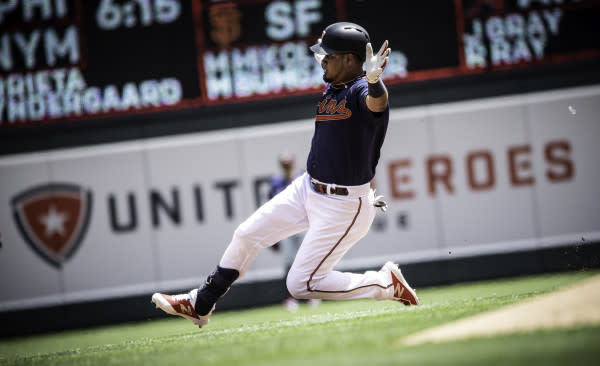
Twins rookie Luis Arraez is having an unexpected but phenomenal season. In 61 games, the 22-year-old is hitting .341 in 211 at-bats with an .853 OPS.
After playing periodically in the first half of the season, Twins manager Rocco Baldelli has put Arraez in the everyday lineup since the All-Star break, and he’s certainly deserving.
Arraez hasn’t demonstrated much power (just three home runs this season), but he rarely strikes out and walks at an average pace. Arraez was never regarded as a top prospect, but his name did come up in July trade talks, according to Dan Hayes of The Athletic.
Even though he’s been a revelation and might be the team’s answer at second base for years to come, should the Twins consider trading him?
Why they should trade him
It was a unique trade deadline this summer, with very few big moves taking place outside of Houston landing Zack Greinke.
Hayes noted that beyond prospects, Arraez was “everyone’s favorite ask” amongst teams who were offering rental players. If teams still come calling about the infielder this winter, could the Twins still end up flipping him for a controllable asset instead of a rental?
The Twins kicked tires on Noah Syndergaard, but the Mets were apparently asking for Byron Buxton (LOL!) as a starting point with top prospects too. If Arraez keeps up his impressive play, maybe the Twins could offer Arraez and one of their top-three prospects to start that conversation again this winter.
Syndergaard’s fastball can reach triple digits and he has a career ERA of 3.71. He’s the exact kind of ace the Twins need and would form a nice 1-2 punch with Jose Berrios.
Maybe a more achievable and lesser expensive option is last year’s Cy Young winner, Blake Snell. In 20 starts this season, Snell has come down to earth a bit with a 4.28 ERA but his 3.39 FIP (Fielding Independent Pitching) suggests he’s been unlucky this year.
He’s currently on the injured list as he underwent surgery to remove a loose body in his throwing elbow but he’s expected back in September. Snell did receive a five-year, $50 million contract last March, but Tampa Bay is a small market with low payroll and wouldn’t be surprising to see them part with him.
Arraez and a solid prospect could be enough to get Snell, although the Rays might not want to trade him so soon after his dominating 2018.
Matthew Boyd was another name who was floated around this summer at the trade deadline. Detroit is going to be in the bottom of the division for years to come and will be open to taking on prospects to see what works for them going forward.
Boyd has struggled a bit in August but he still has an ERA of 4.24 on the season and is striking out 11.8 batters per 9 innings.
He won’t be a free agent until 2023 and although he might not be an ace, a change of scenery from the lowly Tigers could do wonders for him.
Why they shouldn’t have traded him
For starters, it’s a tough sell to part ways with a guy who’s a .300 hitter and is under team control through 2024, especially if all the Twins could’ve got is a rental arm.
Plus, given his position flexibility, Arraez is a huge asset for the Twins.
Then, when you compare Arraez numbers this season to other great hitters’ rookie campaigns you’ll start to drool a little bit.
Arraez vs. Tony Gwynn: The first player that comes to mind, as noted by Indians manager Terry Francona, per the Star Tribune, whose numbers and style of play are similar to Arraez is Gwynn.
Gwynn was a career .338 hitter with just 135 home runs in 20 big-league seasons. It’s not a forecast for the future, but Arraez actually has more impressive first-year numbers than Gwynn had in 1982. Two years later and Gwynn was a top-three MVP candidate.
- Arraez 2019: 61 games:.341 BA, .408 OBP, 10.1 BB%, 7.1 K%
- Gwynn 1982: 51 games: .289 BA .337 OBP, 7.3 BB%, 8.4 K%
Arraez vs. Rod Carew: The next legend that comes to mind is Twins great Rod Carew, who was a career .328 hitter and flirted with a .400 batting average in 1977. Carew hit .388 that year and found himself on the cover of Time Magazine.
Carew won the Rookie of the Year award in 1967, and his first 61 games weren’t as impressive as Arraez’s first 61 games in the MLB.
- Arraez 2019: 61 games:.341 BA, .408 OBP, 10.1 BB%, 7.1 K%
- Carew 1967: 61 games: .319 BA, .361 OBP, 6.8 BB%, 16.1 K%
Obviously, assuming Arraez becomes Gwynn or a Carew is farfetched since both of those players were first-ballot Hall of Famers, and Arraez, at this point, is still a flash in the pan.
It’s very unlikely Arraez will be a career .343 hitter. For the season, Arraez has a BABIP (batting average on balls in play) of .358, meaning regression is inevitable. The league average BABIP is closer to. 300.
But there is some belief Arraez can sustain his production. Over his last 28 days, Arraez owns a BABIP of .297, while having a traditional batting average of .288 during that span.
That means he’s not getting lucky, he’s simply finding hits at a sustainable rate when he puts the ball in play. Now, .288 is not .343, but if that’s who he’s going to be in his career, he’s still an above average second baseman.
It’s certainly easy to say right now that he’s a valuable asset for the Twins. However, if teams come calling about him this winter, and the return piece isn’t a rental pitcher, the Twins should seriously consider it depending on who they get in return.








